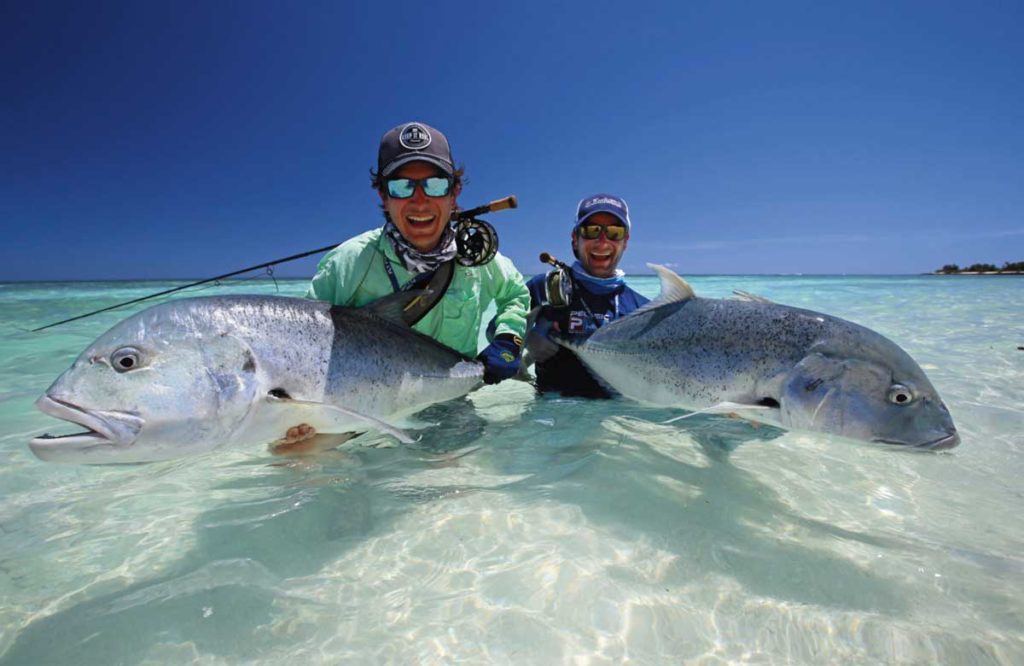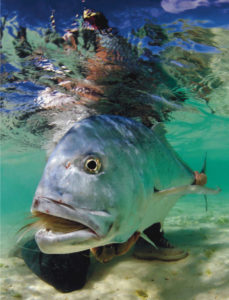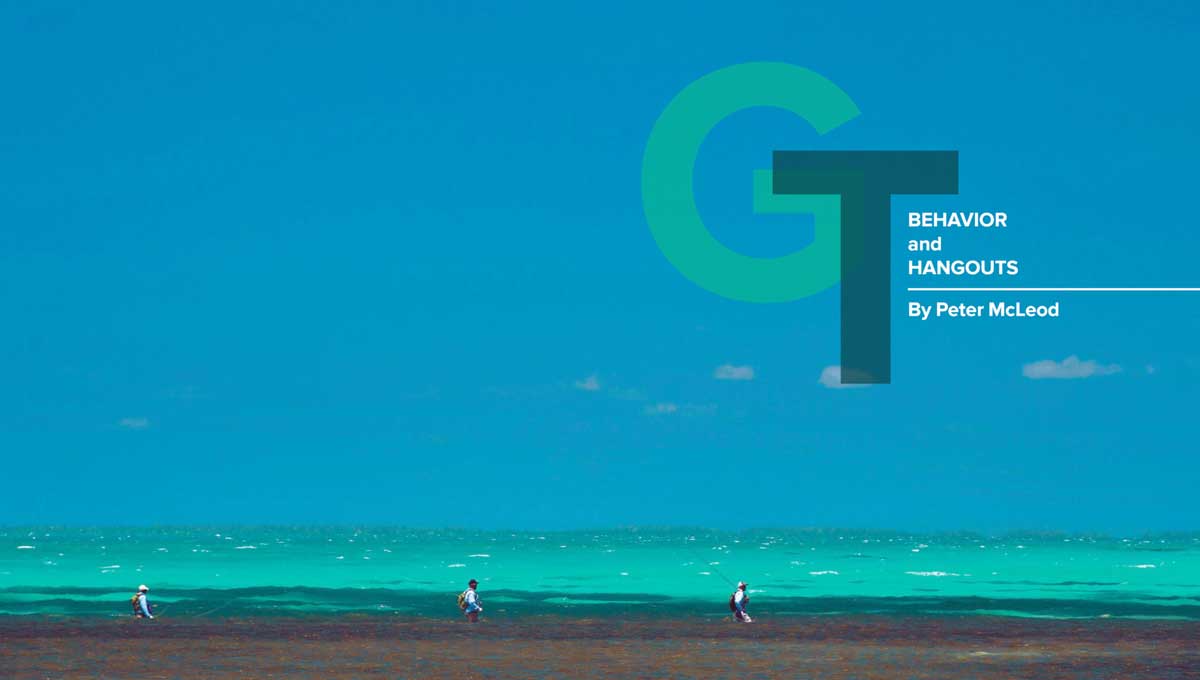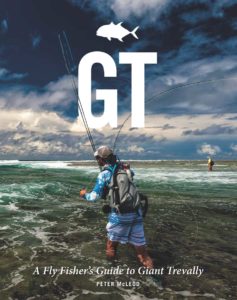Flats Fishing for Giant Trevally, GT Behavior & Hangouts
Catching a Giant Trevally (GT) on a fly rod is the pinnacle of flats fishing: highly challenging, requiring skill and preparation. Peter McLeod of international flyfishing specialists Aardvark McLeod, has now written the first comprehensive book on catching these ‘gangsters of the ocean’. He covers how to catch them, where to catch them, their behaviour, the equipment, tips and techniques from expert guides all round the world, wherever GTs lurk and sporting anglers pit their skills against this most rewarding of quarry. GT, A Flyfisher’s Guide to Giant Trevally, $45 colour hardback, Merlin Unwin Books Ltd.
So where do we find GTs? These predators are one of the most opportunistic feeders swimming in the ocean. To catch GTs on a fly you are first going to have to enter their environment and then hunt them in it. There is nothing random about how GTs move. Their movements are dictated by their unique understanding of their environment and the availability of food. And, in a similar way to humans, individual fish have their own characteristics and preferences.
Although their overriding motivation for being in a particular locale is dictated by water temperature, tide levels, available food sources and seasons, an understanding of the areas they frequent is vital. There is no quick and easy fix; it is just a question of understanding what motivates them, covering the ground and putting in the hours on the flats and the other areas they hang out. The more ground you cover and the more of their environment you can visit, the more chance you have of getting a shot. When that shot comes, you need to be ready as the opportunity comes and goes like a match lit in a wind. It can be not only physically but also mentally challenging to maintain that level of concentration for an extended period of time, often while just trying to stay upright on coral or surf.
As these bruisers are so adaptable, their hunting grounds range from offshore rock pinnacles to coral reef edges, channels, flats and estuarine systems. Juveniles tend to be more prevalent in estuaries and river systems where, like baby tarpon, they feel safe from larger predators and in turn can hunt other bait living there for the same reasons. Once they attain a certain size, perhaps 20-40cm, they will begin to group together and move out to deeper water to find structure such as a coral reef, bombies, drop-offs or channels. These locales contain strong currents where schools of bait are buffeted, making them easy targets for the fast and powerful trevally. As a rule of thumb when on the flats, the larger the group of GTs, the smaller the fish are – with the really big fish tending to remain as singles. The exception to this is a high concentration of food which will draw large concentrations of trevally to an area including the bigger fish which will shoal up again.

As soon as the tide allows, even very large GTs will venture onto flats, headlands and shallow water to hunt, utilising the network of channels or areas of deeper water. GTs can also be found along the reef edge and points where large pounding swells crash on the reef and rock, stirring up food and creating the ideal hunting ground. They will eat pretty much anything that moves or swims and are totally opportunistic. I have seen them charge packs of bait fish, tail on crabs on the flats, and I have even heard of fish along the drop-off ganging up and taking out small sharks. On Goulette island on Farquhar Atoll, the GTs have even figured out the breeding habits of the thousands of Sooty Terns that breed there. In the autumn they will track and eat a whole Sooty Tern – one innovative angler landed a GT on a ‘bird fly’ he had made out of a full-sized black flipflop. The GT ate it whole! For a fly fishermen, these areas of flats and coral drop-offs are the ideal place to hunt them. In an effort to bring them into some kind of order I have decided to follow the ebb and flow of a tidal cycle.
SURFING
Right at the start of the pushing tide, one of the best places to find GTs is in the surf on the reef edge on the incoming tide. At low tide the front of the reef is the perfect place to start, looking in all the cuts and holes. GTs sit in these holes and wait like a trout in a stream for unsuspecting baitfish to be washed over their heads where they are easily intercepted. As the tide begins to gain momentum, the GTs become more active in their anticipation to come onto the flats. Fishermen can then move back across the coral bars as the surf increases and use the waves as windows into the world of the GT. There is nothing quite like watching a wave lift  and seeing three or four GTs surfing down the inside of the wave, using the extra speed and momentum to smash into unsuspecting prey. As the angler is pushed further back from the surf line towards the shore, the GTs will gain access to the flats. It is time for the angler to move and stake out the channels that the GTs use as highways.
and seeing three or four GTs surfing down the inside of the wave, using the extra speed and momentum to smash into unsuspecting prey. As the angler is pushed further back from the surf line towards the shore, the GTs will gain access to the flats. It is time for the angler to move and stake out the channels that the GTs use as highways.
CHANNELS OR GT HIGHWAYS are GT Behavior & Hangouts
Channels are the first sections on the flats to become submerged and the last to lose water. All fish will generally swim in the deepest water available to them, and GTs are no exception. If you study a map of the flats you will clearly see the network of channels that resemble the veins in a leaf. Always look for intersection points from deeper water to lagoons or flats. Bonefish behave in the same way, but earlier in the tidal cycle. In lagoon systems such as Christmas Island, the GTs have preferred paths they will use to gain access to the back of the lagoon and the feeding grounds there. The same goes for flats, often large flats with depressions or channels running through them such as Orvis Flat on Christmas Island, Second Island on Farquhar or Little Snake Island in Sudan. These GT highways provide the perfect access points to the flats, just like a motorway connecting towns and cities. It can be worth staking out these highways on an incoming tide and spending a little time to see what comes along heading onto the flats. If you have the patience, you will not be disappointed.
THE FLATS
Whether it be pancake flats, turtle grass flats, coral flats or sand flats, once the water reaches critical height the GTs will slip over the edge and start to prowl like a pack of dogs, or in some cases as a lone wolf. They tend to be attracted to depressions (deeper areas within the flat), white holes and any structure that they can use as an ambush point. The great thing about having such a large fish in such shallow water is that not only can you spot them from a considerable distance if the visibility is good, but they move water, giving away their position. Always be on the lookout for bow waves, nervous water moving against the tide and also smashing of the water surface as they hunt. Keep an eye out for birds which will often track them across the flats, looking for an easy meal as the GTs stun baitfish.
Pancake flats by their very nature are an excellent hangout for GTs. Pancake flats are small hard coral flats, often covered in turtle grass, which have deep water all around them. The pancake flats inside the Christmas Island lagoon for example have long been an ideal bonefish spot, as large fish can scoot off the flat in a hurry if they become alarmed. By the same token deep water right next to shallow flats will encourage GTs to add them to their patrol route. Pancake flats inside atoll lagoons or estuaries are particularly good on dropping tides, sucking small fish off the flats much like tiger fish zoning in on bulldog baitfish on the Zambezi.
On large open flats with a combination of turtle grass and sand such as the Cosmoledo lagoon or Green Mile on Farquhar, always keep an eye out for stingrays. Like permit and bonefish, GTs like an easy meal so will follow stingrays along the flats as they grub around. Normally going dark and adopting the colour of their host, they can sometimes be hard to pick out, so if you see a stingray it’s always worth a cast in their direction. These ‘Ray-Rider GTs’ will jump on any food item that wanders in their path. Tim Babich believes that this is a two-way relationship and the rays use the GT as an early warning device against sharks and other predators. To this end he has seen rays follow a GT after it was spooked off him, catch up with it and then begin feeding again. Although baitfish patterns remain effective, they can be refused if the GT is totally clued into the feeding of the ray in this situation – they are looking for food stirred up off the bottom by the ray. In this instance a tan Clouser or large crab pattern can be highly effective……….
GT BEHAVIOR AND HANGOUTS
by Peter Mcleod
SUBSCRIBE TO READ THE REST OF THE ARTICLE
Flats and Surf Fishing Offers Great Opportunities
Fishing the flats with a fly rods offer opportunities for several species and global destinations. Fishing the Northern California surf for Corbina, you had better practice your casting and have a striping basket. Take a adventure to South Carolina’s Low Land Flats for Redfish to gain more skill. How about a trip to the Indian Ocean or Pacific for bison of the flats, a true challenge.



